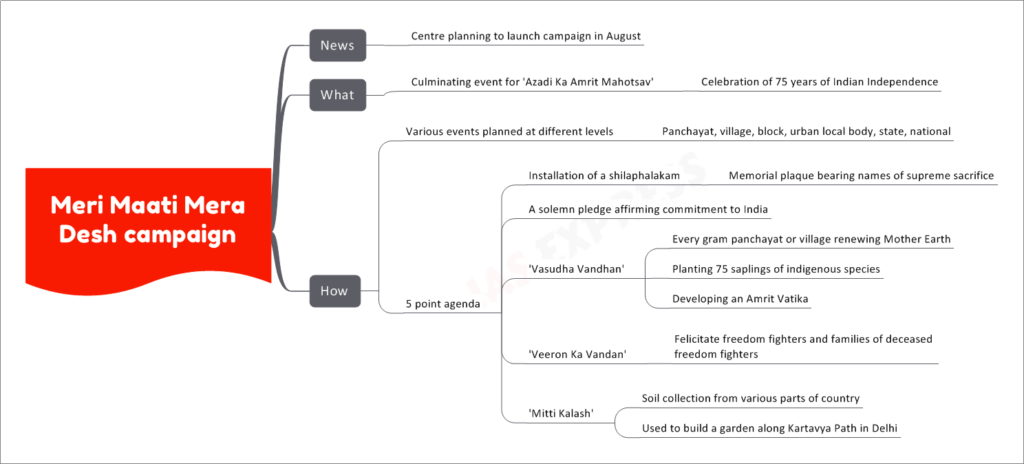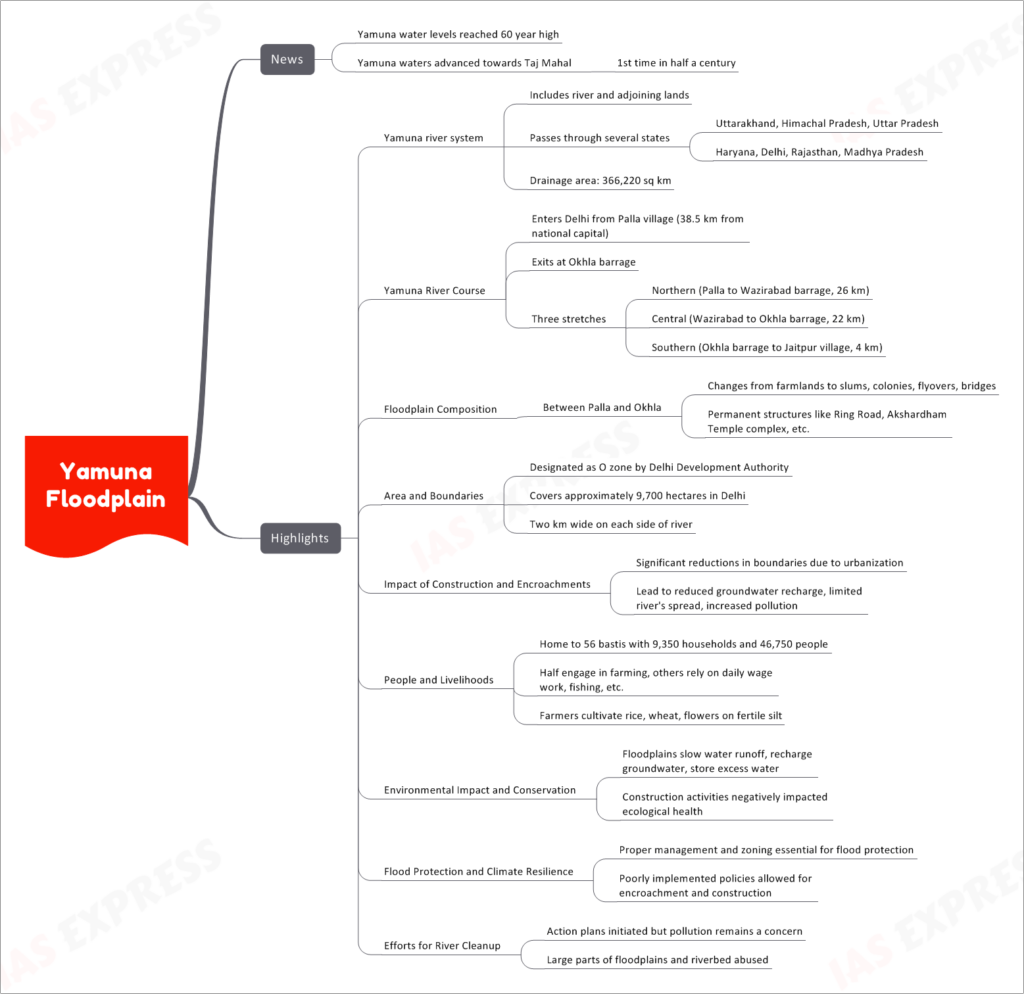[Newsbits] 25.07.2023

‘Meri Maati Mera Desh’ campaign
News
- The Indian government is planning to launch the 'Meri Maati Mera Desh' campaign in August.
What is the Campaign About?
- The 'Meri Maati Mera Desh' campaign is a culminating event for the 'Azadi Ka Amrit Mahotsav,' which celebrates 75 years of Indian Independence.
How will the Campaign be Executed?
- The campaign will involve various events and activities planned at different levels, including panchayat, village, block, urban local body, state, and national levels.
5 Point Agenda of the Campaign:
- Installation of a Shilaphalakam:
- A shilaphalakam is a memorial plaque bearing the names of those who made the supreme sacrifice for the country.
- Solemn Pledge Affirmation:
- Participants will take a solemn pledge affirming their commitment to India and its progress.
- 'Vasudha Vandhan':
- Every gram panchayat or village will renew its commitment to Mother Earth.
- This will involve planting 75 saplings of indigenous species and developing an Amrit Vatika (an ambrosial garden).
- 'Veeron Ka Vandan':
- The campaign aims to felicitate freedom fighters and the families of deceased freedom fighters, honoring their contributions to the nation.
- 'Mitti Kalash':
- Soil will be collected from various parts of the country.
- This collected soil will be used to build a garden along Kartavya Path in Delhi, symbolizing the unity and diversity of the nation.
Yamuna Floodplain
News
- Recently, the water levels of the Yamuna river reached a 60-year high.
- For the first time in half a century, the Yamuna waters advanced towards the iconic Taj Mahal.
Yamuna River System
- The Yamuna river system includes the river and its adjoining lands.
- The river passes through several states: Uttarakhand, Himachal Pradesh, Uttar Pradesh, Haryana, Delhi, Rajasthan, and Madhya Pradesh.
- It has a vast drainage area covering 366,220 square kilometers.
Yamuna River Course
- The Yamuna river enters Delhi from the village of Palla, which is located 38.5 km from the national capital.
- It exits Delhi at the Okhla barrage.
- The river can be divided into three stretches within Delhi:
- Northern stretch: From Palla to Wazirabad barrage, spanning 26 km.
- Central stretch: From Wazirabad to Okhla barrage, spanning 22 km.
- Southern stretch: From Okhla barrage to Jaitpur village, spanning 4 km.
Floodplain Composition
- The floodplain between Palla and Okhla undergoes various changes, ranging from farmlands to slums, colonies, flyovers, and bridges.
- It also includes permanent structures like the Ring Road and the Akshardham Temple complex.
Area and Boundaries
- The floodplains are designated as O zone by the Delhi Development Authority.
- They cover approximately 9,700 hectares in Delhi and are two kilometers wide on each side of the river.
Impact of Construction and Encroachments
- Urbanization and construction activities have significantly reduced the boundaries of the floodplains.
- This has led to reduced groundwater recharge, limited the river's spread during floods, and increased pollution.
People and Livelihoods
- The Yamuna floodplains are home to 56 bastis (settlements) with 9,350 households and around 46,750 people.
- Half of the population is engaged in farming, while others rely on daily wage work, fishing, etc.
- Farmers cultivate rice, wheat, and flowers on the fertile silt of the floodplains.
Environmental Impact and Conservation
- The floodplains play a crucial role in slowing water runoff, recharging groundwater, and storing excess water during floods.
- However, construction activities have negatively impacted the ecological health of the floodplains.
Flood Protection and Climate Resilience
- Proper management and zoning are essential for flood protection and climate resilience.
- Poorly implemented policies have allowed for encroachments and construction on the floodplains.
Efforts for River Cleanup
- Various action plans have been initiated to clean up the Yamuna river, but pollution remains a major concern.
- Large parts of the floodplains and riverbed have been abused, leading to environmental degradation.
Mihir Bhoj
News
There is a row in Haryana over the unveiling of a statue related to Mihir Bhoj.
Who was Mihir Bhoj?
Mihir Bhoj was a 19th-century king belonging to the Gurjar Pratiharas, a prominent dynasty in medieval India.
Significance of Mihir Bhoj
Mihir Bhoj was notable for his success in the tripartite struggle for Kannauj, a significant city in northern India during that period. The tripartite struggle involved three contending powers vying for control over Kannauj:
- Gurjara-Pratihara: Mihir Bhoj's own dynasty, which he represented.
- Rashtrakutas of Deccan: A powerful dynasty ruling over the Deccan region of India.
- Palas of Bengal: Another influential dynasty ruling over Bengal.
Mihir Bhoj's Conquests
During his reign, Mihir Bhoj achieved several conquests and expansions of his territory:
- He captured Gujarat and Malwa from the Gujarat-Rashtrakutas, adding these regions to his kingdom.
- Additionally, he acquired territories in Gorakhpur from the Palas, further strengthening his dominion.
Geographic Reach of Mihir Bhoj's Rule
- Mihir Bhoj's influence and authority extended from Kashmir in the north to Gujarat in the west.
- He conquered and controlled areas in the Deccan and Malwa regions, showcasing the vast expanse of his rule.
Timeline of Mihir Bhoj's Reign
Mihir Bhoj ruled during the period of 836 CE to 885 CE.
Rajasthan’s Minimum Guaranteed Income Bill
News
- The Rajasthan state assembly has passed the Rajasthan’s Minimum Guaranteed Income Bill.
What is the Bill?
- It is a state legislation aimed at guaranteeing wages or pensions to the adult population of Rajasthan.
Highlights of the Bill
- Three Categories of Guaranteed Income:
- Right to minimum guaranteed income
- Right to guaranteed employment
- Right to guaranteed social security pension
- Guaranteed Employment Provision:
- All state families are entitled to guaranteed employment for 125 days per year.
- In urban areas, it is implemented through the "Indira Gandhi Shahri Rozgar Guarantee Yojana."
- In rural areas, it is implemented through the "Mahatma Gandhi National Rural Employment Guarantee Act" (MGNREGA).
- The MGNREGA initially provides guaranteed employment for 100 days, but the Rajasthan government has increased this to 125 days by supplementing an additional 25 days.
- Program Officer Implementation:
- In rural areas, the implementation is overseen by a Program Officer not below the rank of Block Development Officer.
- In urban areas, the Executive Officer of the local body is responsible for implementation.
- The employment provided should be within 5 km of the job card registration.
- If employment is not provided within 15 days of registration, the individual is entitled to receive unemployment allowance on a weekly basis.
- Minimum Pension Provision:
- A minimum pension of Rs 1,000 per month is provided to the aged, disabled, widows, and single women.
- The pension amount is subject to an annual increase of 15%.
Significance of the Bill
- The implementation of the Rajasthan’s Minimum Guaranteed Income Bill will result in additional government expenditure amounting to Rs 2,500 crore per year.
Zero FIR
Zero FIR has been filed in Manipur.
What is a Zero FIR?
- A Zero FIR is a First Information Report (FIR) filed by the police for an offense that falls under another police station's jurisdiction.
- The term "Zero FIR" is not explicitly defined in the Indian Penal Code (IPC) or the Code of Criminal Procedure (CrPC) of 1973 but is governed by police regulations.
- It is recorded under Section 154 of CrPC, and it includes all information related to a cognizable offense.
Important Elements of Zero FIR
- Relates to a cognizable offense, which allows for immediate arrest without a warrant.
- Can be given orally or in writing to the police station head.
- Must be written and signed by the informant.
- Key points are recorded in the daily diary of the police station.
Why Zero FIR is Necessary
- Prevents victims from running from one police station to another to file the FIR for the same offense.
- Ensures speedy redressal to the victim by initiating the investigation immediately.
How Zero FIR Works
- The victim can approach any police station to file the Zero FIR, regardless of the jurisdiction.
- The police station that receives the Zero FIR registers it and begins the initial investigation.
- The case is then transferred to the relevant police station where the offense took place.
- The receiving station registers a fresh FIR with a regular FIR number after receiving the Zero FIR.
Who Advocated for Zero FIR?
- The provision for Zero FIR was recommended by the Justice Verma Committee, which was formed after the 2012 Delhi rape case.
- The Justice Verma Committee aimed to suggest amendments to Criminal Law to enable faster trial and enhanced punishment for criminals accused of sexual assault against women.
Conclusion
Zero FIRs play a crucial role in the Indian criminal justice system, ensuring prompt action and redressal to victims of cognizable offenses. By allowing FIRs to be filed in any police station, the Zero FIR provision prevents unnecessary delays and ensures a more efficient investigation and resolution of criminal cases.
If you like this post, please share your feedback in the comments section below so that we will upload more posts like this.





